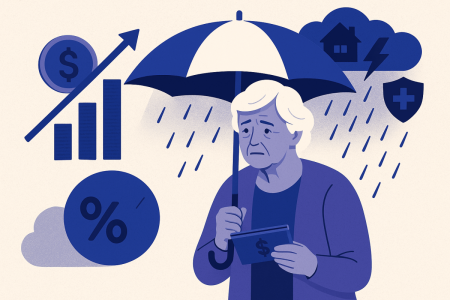What July 1 brings for Aussie seniors
- Replies 0
As July dawns, a new financial year brings a blend of goodies and grumbles for Aussies, especially our older crowd. Many payments and rules are being tweaked.
For example, the Age Pension itself gets a modest lift: from Monday, asset-tested couples will receive $34.50 extra per fortnight and singles $22.50. The government insists this is “cost of living relief” – essentially a two-handed indexation on welfare and wages. In practical terms, that’s about $585 more a year for a solo pensioner and around $897 for a couple (combined).
But it’s not all extra cash – some bills bite too.
Energy regulators in NSW, SA and Queensland are hiking electricity prices, and tobacco lovers will be hit with a sting: from July 1 menthol and certain flavour additives vanish from cigarette packs, while all packs become standardised, with extra quit messages inside.
In short, retirees may count a few more dollars in hand, but also face tougher new rules on the road (and in the smoking lounge).
The devil is in the details. While the headline pension rate barely changes, the thresholds around it do. Income and asset cut-offs are being lifted about 2.4%, meaning more people can qualify or keep a bigger pension.
For instance, the income test free area rises from $212 to $218 a fortnight for singles (and $372 to $380 for couples), letting you earn a little more before payments start to drop. On the assets side, a homeowner couple’s limit for a full pension increases from $470,000 to $481,500, and a single homeowner’s from $314,000 to $321,500.
Even the “deeming” thresholds on bank savings are nudged up: singles can now hold $64,200, earning the low 0.25% deemed rate (up from $62,600) before higher rates kick in.
As one explainer bluntly puts it, “the pension rate is not going u,p but increased income and asset thresholds mean thousands more will be entitled to benefits”. In other words, many older Aussies will stay or become eligible for at least a part pension, even if they work or own more assets.
The ripple effects extend beyond pensions. Workers will see small pay bumps too – the Fair Work Commission granted a 3.5% rise in the minimum wage (now $24.95/hour), and the compulsory superannuation guarantee edges up from 11.5% to 12% of wages. That final 0.5% super boost may seem tiny, but over decades it can add a few tens of thousands to one’s nest egg.
Meanwhile, most Centrelink payments (disability, carers, veterans’ allowances, etc.) and related thresholds are indexed by 2.4% as well – the same as inflation. In raw terms, Centrelink beneficiaries are getting a smidge more, but critics note essentials like rent and power have already skyrocketed past 2.4%.
Every extra dollar can count in retirement. Analysts point out that a $6/fortnight lift in the pension free-income limit may seem trivial, but across a year that’s $156 – enough, they say, “to fund a weekend getaway or cover a few much-needed prescriptions”.
It’s these little increases that stitch into a slightly bigger safety net. (The flip side: fees and levies are also creeping up. For instance, Medicare levy surcharge thresholds tick higher, and some state road rules now bring heftier fines – say, failing to slow to 25 km/h for a broken-down vehicle can cost up to $1,648 in SA.)
Beyond wallets, daily life also shifts. One of the boldest moves is an anti-smoking push: from July 1 menthol cigarettes and other flavoured tobacco products will be banned.
Packs will standardise to 20 sticks each, lose any colours or ‘smooth’ branding, and come with fresh warning graphics. The Health Department says the goal is to cut the appeal of smoking and help people quit – though older smokers may bristle at the new “tasteless” reality.
Also on the roads, new cameras go live: AI-enabled speed cameras can now spot drivers using a phone, meaning fines for hands-free violations will be more certain. (In case you’re cruising by an emergency scene – remember, in many states the slow-down rule has tightened: e.g. in SA you must now drop to 25 km/h past breakdown crews.)
Through all this, the idea is clear: indexation will keep benefits roughly in step with prices. Payments and thresholds have been upped by the same 2.4% CPI increase experienced in the past year. This means seniors shouldn’t see their pensions eaten alive by inflation, at least for now.
However, many retirement experts note that actual costs (especially housing, power and healthcare) have climbed faster than 2.4%, so much of the relief may be nominal. On balance, the mixed package of July 1 changes is unlikely to transform anyone’s life, but it does give a small breathing space.
For example, a couple on the full pension will now net around $56,000 per year (up from about $54,100), combining both partners, roughly $900 more annually. That might not buy a big holiday, but it could mean an extra treat now and then – a nice lunch out or a bit more heating in winter.
So what’s the final tally? Some Aussies will be a bit better off – thanks to higher pensions, wages, and super – but others will face bigger bills or new rules. It’s a bit like getting a small Christmas gift in your pocket, alongside an unwelcome fine in your mail.
As the year turns, we’re left with a question for our readers: How will you feel about these changes? Will you tuck away that extra pension cash for a rainy day, or splash it on something fun? Are you relieved by the slight pay rise, or worried about higher energy and stricter smoking laws?
Let us know – are you celebrating or commiserating this July 1?
Read more: Cost of living relief kicks in July 1: What Aussies can expect
For example, the Age Pension itself gets a modest lift: from Monday, asset-tested couples will receive $34.50 extra per fortnight and singles $22.50. The government insists this is “cost of living relief” – essentially a two-handed indexation on welfare and wages. In practical terms, that’s about $585 more a year for a solo pensioner and around $897 for a couple (combined).
But it’s not all extra cash – some bills bite too.
Energy regulators in NSW, SA and Queensland are hiking electricity prices, and tobacco lovers will be hit with a sting: from July 1 menthol and certain flavour additives vanish from cigarette packs, while all packs become standardised, with extra quit messages inside.
In short, retirees may count a few more dollars in hand, but also face tougher new rules on the road (and in the smoking lounge).
The devil is in the details. While the headline pension rate barely changes, the thresholds around it do. Income and asset cut-offs are being lifted about 2.4%, meaning more people can qualify or keep a bigger pension.
For instance, the income test free area rises from $212 to $218 a fortnight for singles (and $372 to $380 for couples), letting you earn a little more before payments start to drop. On the assets side, a homeowner couple’s limit for a full pension increases from $470,000 to $481,500, and a single homeowner’s from $314,000 to $321,500.
Even the “deeming” thresholds on bank savings are nudged up: singles can now hold $64,200, earning the low 0.25% deemed rate (up from $62,600) before higher rates kick in.
As one explainer bluntly puts it, “the pension rate is not going u,p but increased income and asset thresholds mean thousands more will be entitled to benefits”. In other words, many older Aussies will stay or become eligible for at least a part pension, even if they work or own more assets.
The ripple effects extend beyond pensions. Workers will see small pay bumps too – the Fair Work Commission granted a 3.5% rise in the minimum wage (now $24.95/hour), and the compulsory superannuation guarantee edges up from 11.5% to 12% of wages. That final 0.5% super boost may seem tiny, but over decades it can add a few tens of thousands to one’s nest egg.
Meanwhile, most Centrelink payments (disability, carers, veterans’ allowances, etc.) and related thresholds are indexed by 2.4% as well – the same as inflation. In raw terms, Centrelink beneficiaries are getting a smidge more, but critics note essentials like rent and power have already skyrocketed past 2.4%.
Every extra dollar can count in retirement. Analysts point out that a $6/fortnight lift in the pension free-income limit may seem trivial, but across a year that’s $156 – enough, they say, “to fund a weekend getaway or cover a few much-needed prescriptions”.
It’s these little increases that stitch into a slightly bigger safety net. (The flip side: fees and levies are also creeping up. For instance, Medicare levy surcharge thresholds tick higher, and some state road rules now bring heftier fines – say, failing to slow to 25 km/h for a broken-down vehicle can cost up to $1,648 in SA.)
Beyond wallets, daily life also shifts. One of the boldest moves is an anti-smoking push: from July 1 menthol cigarettes and other flavoured tobacco products will be banned.
Packs will standardise to 20 sticks each, lose any colours or ‘smooth’ branding, and come with fresh warning graphics. The Health Department says the goal is to cut the appeal of smoking and help people quit – though older smokers may bristle at the new “tasteless” reality.
Also on the roads, new cameras go live: AI-enabled speed cameras can now spot drivers using a phone, meaning fines for hands-free violations will be more certain. (In case you’re cruising by an emergency scene – remember, in many states the slow-down rule has tightened: e.g. in SA you must now drop to 25 km/h past breakdown crews.)
Through all this, the idea is clear: indexation will keep benefits roughly in step with prices. Payments and thresholds have been upped by the same 2.4% CPI increase experienced in the past year. This means seniors shouldn’t see their pensions eaten alive by inflation, at least for now.
However, many retirement experts note that actual costs (especially housing, power and healthcare) have climbed faster than 2.4%, so much of the relief may be nominal. On balance, the mixed package of July 1 changes is unlikely to transform anyone’s life, but it does give a small breathing space.
For example, a couple on the full pension will now net around $56,000 per year (up from about $54,100), combining both partners, roughly $900 more annually. That might not buy a big holiday, but it could mean an extra treat now and then – a nice lunch out or a bit more heating in winter.
So what’s the final tally? Some Aussies will be a bit better off – thanks to higher pensions, wages, and super – but others will face bigger bills or new rules. It’s a bit like getting a small Christmas gift in your pocket, alongside an unwelcome fine in your mail.
As the year turns, we’re left with a question for our readers: How will you feel about these changes? Will you tuck away that extra pension cash for a rainy day, or splash it on something fun? Are you relieved by the slight pay rise, or worried about higher energy and stricter smoking laws?
Let us know – are you celebrating or commiserating this July 1?
Read more: Cost of living relief kicks in July 1: What Aussies can expect









